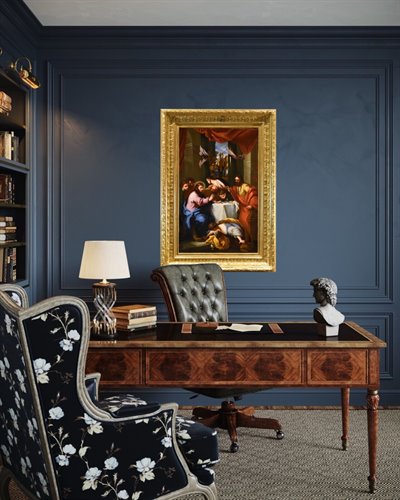Cristo e la Maddalena al banchetto del Fariseo
Benedetto Luti (Firenze, 1666 - Roma, 1724)
Benedetto Luti
(Florence, 1666 - Rome, 1724)
Christ and Mary Magdalene at the banquet of the rich Pharisee Simon
Oil on canvas
73 x 46 cm.
Framed 93 x 67 cm.
During a banquet in the house of the rich Pharisee Simon, which Jesus and his disciples were attending, a woman, sincerely repentant of her sins and who tradition has always identified as Mary Magdalene, came with a jar of perfumed oil (Gospel according to Luke, VII: 36-38); she stopped behind him, crouched at his feet and began to bathe them with tears, then dried them with her hair and finally kissed them, perfuming them with the precious ointment.
The Pharisee criticized Jesus for allowing such a sinful woman to touch him, but Jesus, turning to the woman, said to her: “Your sins are forgiven. Your faith has saved you; go in peace”. To the Pharisees, on the other hand, he replied with these words: ‘Her many sins have been forgiven, for she loved much. But he who is forgiven little, loves little’.
The episode is extremely significant, symbolizing two totally opposite approaches to life, and the painting is conceived as a dramatic conflict between the Pharisees and Jesus: the world of material values and religious dogmatism of the Pharisees is opposed to the Christian world of sublime ideas and noble acts, a world of sympathy, charity and goodness.
Certain of the justice and morality of his position, Jesus and his disciples, in accepting the words of their master, oppose the Pharisees, whose faces show a lack of understanding, annoyance and even anger.
The painting, of exquisite quality, is compared with a canvas painted by the Florentine painter Benedetto Luti in about 1692 for the Florentine knight Giovanni Niccolò Berzighelli (oil on canvas, 305x198 cm), shortly after his arrival in Rome, as attested by three letters exchanged between Benedetto and his teacher D.A. Gabbiani, now part of the English collection of Viscount Scarsdale at Kedleston Hall in Derbyshire.
A pupil of Maratta in Rome and one of the protagonists of Roman painting between the end of the 17th and the beginning of the 18th century, he developed his own personal style that led him to be one of the finest and most precocious interpreters of Rococo painting, much appreciated and in demand.
Our canvas is therefore a version, presumably painted by the master himself or by one of his trusted collaborators, that differs from the English one in that it shows the parade plates behind the Christ. This additional detail is similar to the other version attributed to Benedetto Luti and now in the National Gallery of Umbria, Palazzo dei Priori (https://catalogo.cultura.gov.it/detail/HistoricOrArtisticProperty/1000016641).
ADDITIONAL INFORMATION:
The painting is sold complete with a beautiful golden wooden frame and is accompanied by a certificate of authenticity and an iconographic description.
We organize the shipping of the purchased works, both in Italy and abroad, through professional and insured carriers.
In the case of a purchase by a non-Italian client, it will be necessary to obtain an export permit, which takes approximately 10-20 days. Our gallery will take care of the entire process until the permit is obtained. All costs for this procedure are included.
It is also possible to see the painting in the gallery in Riva del Garda, we will be happy to welcome you and show you our collection of works.
Contact us, without obligation, for any additional information.
Follow us also on:


